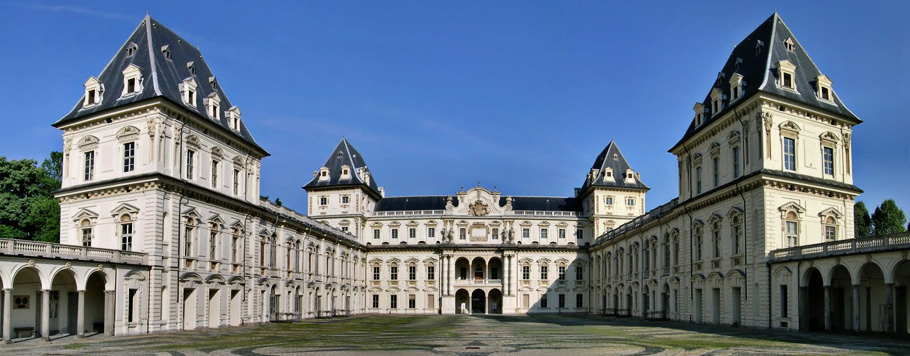 un progetto di
un progetto di 
Villa fluviale di proprietà di Renato Birago, discendente della famiglia Trivulzio, il Castello del Valentino è acquistato da Emanuele Filiberto duca di Savoia nel 1564, all’indomani della pace di Cateau Cambrésis e del trasferimento della capitale del ducato da Chambery a Torino. Collocata in una regione dal territorio non pianeggiate detta “Vallantinum”, da cui il nome, è trasformata in “maison de plaisance” sul modello d’oltralpe all’inizio del Seicento per volere di Cristina di Francia, sposa di Vittorio Amedeo di Savoia e, dopo la morte del marito, prima Madama Reale. La duchessa affida il progetto agli ingegneri di corte Carlo e Amedeo di Castellamonte che, sullo schema del pavillom-système francese, raddoppiano l’esistente, delimitando il volume costruito parallelo al Po con due torri, poi raccordate da terrazze a due nuovi padiglioni innalzati verso la città, tra loro collegati da un’esedra. La composizione del Palazzo del Valentino è così qualificata da una simmetria evidenziata da un avancorpo nella facciata principale, rivolta verso il fiume, e da un atrio da cui partono due scaloni simmetrici che conducono al salone d’onore, nel fronte verso Torino. All’interno, il salone e i due appartamenti del piano nobile, destinati a Cristina e al principe ereditario, sono decorati da maestranze provenienti dalla regione dei laghi. Non più residenza di corte, nei primi decenni dell’Ottocento il palazzo ospita la Scuola di Veterinaria, poi è adibito a caserma militare ed è quindi ceduto al Demanio dello Stato nel 1850. Scelto dal Ministro delle Finanze Camillo Cavour quale sede della Sesta Esposizione Nazionale dei Prodotti di Industria del 1858, compreso nell’area già destinata a parco pubblico, il palazzo è allora restaurato su progetto di Luigi Tonta e Domenico Ferri che, sostituendo alle terrazze tra i padiglioni due gallerie costruite in adesione al linguaggio storicista, ribaltano il fronte principale verso la città, segnando la definitiva trasformazione in “castello”. Nel 1859, la legge Casati stabilisce il riordino degli studi di ogni ordine e grado e decreta l’apertura di due nuove scuole di applicazione per gli ingegneri, a Milano e a Torino dove la Scuola è inaugurata, l’anno successivo, nei locali del Castello del Valentino. Oggetto di interventi di ampliamento e di restauro, proprietà del Politecnico di Torino, istituito dall’unione della Scuola di applicazione con il Regio Museo Industriale nel 1906, il Castello del Valentino è iscritto nella Lista del Patrimonio mondiale dell’UNESCO dal 1997, compreso nel sito seriale “Le residenze sabaude”.
The origins of the name of the Valentino Castle, bought by Emmanuel Philibert in 1564, after his official arrival in Piemonte, following the Cateau-Cambrésis Treaty and the transfer of the Savoy capital to Turin, refer to the geomorphological nature of the land, already named “Vallantinum”, not flat and even, but marked by the presence of a natural valley with watercourse, called “bealera del Valentino”, which still flows underground.It was Christine of France, wife of Victor Amadeus I and after his husband’s death first Madama Reale, who promoted the conversion of the building (in XVII century) into maison de plaisance according to the French model.In conformity with the French pavillon-système, the architects Carlo and Amedeo di Castellamonte conceived the construction of an impressive building by doubling the existing architectural structure. The forepart extending toward the Po can be identified as the symmetrical focus of the whole building. At the noble floor, the Salone d’onore is the center of a symmetrical plan designed by two identical apartments, towards Turin and towards Moncalieri, in which famous painters and stucco workers coming from the Lake region worked. In the middle of the century, on the left side of the Po a large city park was created, whose project was presented on the occasion of the Sixth National Exposition of Industrial Products by the Finance Minister Camillo Benso Conte di Cavour at the Valentino Castle, restored on the basis of the Luigi Tonta and Domenico Ferri’s project. Conforming to the Eclettism culture spread in that period, through a historicist language, the terraces linking the two towers were replaced by two big galleries. The XIX century works adjusted some stuccoes and paintings of the rooms too and, above all, changed completely the main frontage towards Turin, by marking the change from the idea of palace to the XIX century idea of “castle”. In 1859, the so-called Casati Law marked the rearrangement of the Italian educational programs at different level (primary, secondary, higher education) and in Turin it symbolized the official opening of the Royal School of Application for Engineers, at the beginning of the Sixties at the Valentino Castle. After many subsequent expansion and restoration works, the Castle began to be used as university seat, place where research and specific studies can be carried out. It also represented a center of scientific and technological experimentations which led to the best choices for the safeguard and preservation of cultural heritage.
Contatti
Castello Del Valentino
Viale Mattioli, 39
10125 Torino
Informazioni generali
E-mail: info.castellodelvalentino@polito.it
Web: residenzereali.it